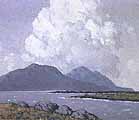Paul Henry & Achill Island (continued)« previous | PAGE 2 OF 6 | next page »
|
It was also while in Paris that Paul Henry met his first wife, Grace. The daughter of a Scots preacher, the Rev John Mitchell, Grace's mother was said to be a cousin of the poet Lord Byron. Paul and Grace, who was also an artist, married in 1903 in London, where they had by now settled. At this time Paul Henry was earning a modest living as an illustrator. He became an honorary member of the Fitzroy Street Group, a gathering of English painters that included William and Albert Rothstein, Walter Sickert, Spencer Gore and Harold Gilman. Other honorary members included the Irish painter Jack B. Yeats and and Hugh Lane, the distinguished art dealer and collector.
Hugh Lane (later Sir Hugh) was a nephew of Lady Gregory, the Irish folklorist and writer. Hugh developed a passion for Irish art, establishing the Dublin Municipal Gallery of Modern Art (now the Hugh Lane Municipal Gallery of Modern Art) in 1908. He was appointed director of the National Gallery of Ireland in 1914 but tragically was drowned in the German attack on the Lusitania in 1915. Hugh Lane recommended Paul Henry's drawings to his friend Dermod O'Brien, a leading member of the Royal Hibernian Academy. O'Brien became president of the somewhat conservative Academy from 1910 to 1945.
In 1909 the Henrys were still working in London, though Paul also had a cottage in rural Surrey. In April of that year Paul Henry's good friend Robert Lynd, a writer, had married the novelist and poet Sylvia Dryhurst and the couple honeymooned on Achill Island. Lynd passionately recommended Achill to Paul Henry. Robert Lynd wrote a number of books about Ireland, including 'Home Life in Ireland', published in 1909, and 'Rambles in Ireland', published in 1912 and illustrated with Paul Henry pictures. Interestingly, given the lack of reference to the political upheavals of 1916-1923 in Paul Henry's work, Robert Lynd was a nationalist, a member of Sinn Fein, and author of an essay 'The Ethics of Sinn Fein' published in The Irish Yearbook in 1909. Lynd wrote this about Achill in 1909:
"... Here amid the gloom and the dark wind, rises a land populous in parts with cottages as a city with human beings. It is a place of tiny dwellings and tiny farms. Out in the fields you see the women labouring and bringing wonder into the rocky darkness of the island with their heavy petticoats of red and blue that you will not surpass for colour in a Titian. The men dig the earth into strange shapes - furrows and ridges that you would conceive might be dug blindly by night. The social spirit is here, however, making continual war on the hungry bareness of things. The people delight in dancing and song and old men scrape a living from twittering fiddles on the earthen cottage floors in the evenings."
(from 'Home Life in Ireland', quoted in Mary Cosgove, 'Paul Henry and Achill Island', in Ullrich Kockel (Ed), 'Landscape, Heritage and Identity', pub. Liverpool University Press, 1995)
Before setting off for a proposed two week holiday on Achill with his wife Grace, Paul Henry read J.M. Synge's Riders to the Sea, a short play that was to have great resonance with some of Paul Henry's paintings and his view of the harshness and tragedy of life on an island on the west of Ireland. Mary Cosgrove quotes Paul Henry's observations on J.M. Synge, from his autobiography:
"... There was something in Synge that appealed to me very deeply. He touched some chord which resounded as no other music ever had done".
(Paul Henry, 'An Irish Portrait', pub. 1953)
|
|
|

Achill Head
by Paul Henry
Paul Henry gallery
Click the title above for a gallery of Paul Henry paintings
Further Reading

Paul Henry
by S.B. Kennedy
Robert Henri & His Circle
by W. Homer
My People: The Portraits of Robert Henri
By Valerie Ann Leeds
Robert Henri: His Life and Art
by Bennard Perlman
|


